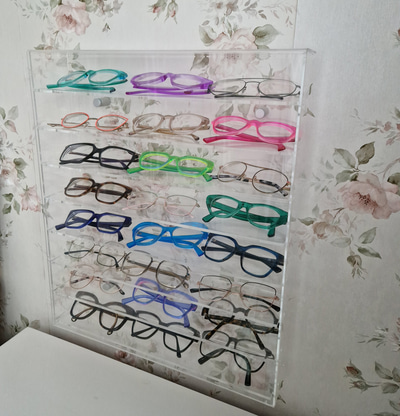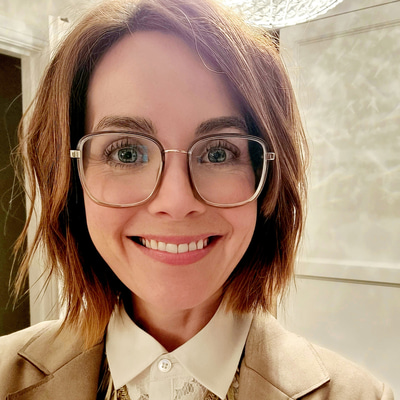- OT
- Industry
- Eyewear and lenses
- “I always look for interesting shapes and designs, and colour really is my thing”
Me and my glasses
“I always look for interesting shapes and designs, and colour really is my thing”
Lorna Robinson, head of buying for Hakim Group, on colourful frames, expanding comfort zones, and taking patients on an eyewear journey

20 April 2023
How many pairs of spectacles and sunglasses do you own?
Optical and sun together, it’s probably between 30 and 40 pairs, and ever-increasing. I have display cabinets in my dressing room for glasses. I’ve got one for sun and one for optical. I like to be able to see my frames: I don’t want them shut in a drawer. I spent a lot of time researching storage solutions. Understandably, there aren’t many for end-users and I didn’t want optical poles. I managed to find a display cabinet that is actually meant for model cars. It has a cover so the shelves don’t get dusty. It’s perfect. I’m now at capacity in my optical one, so I’m going to have to find more space around the house to store my glasses.What frame shapes, colours or styles do you usually go for?

In terms of how I want to express myself, how I want to look, and the variety that I want – I don’t want to only be able to wear a round or rectangle frame. I want to wear whatever I feel like. People will tell me: “You’ve just got one of those faces, everything suits you.” I don’t actually think that’s true. The difference is that I try everything on so the proportion of what suits me is much bigger, because I don’t discount a load of frames.
Squares are a really good example. I’ve got quite a petite fit. It took me ages to find an oversized square, because they were all way too big for me. I finally managed it, but I tried on a lot that didn’t suit me in the meantime. I think that is the crucial thing – if you feel fantastic in something, then you should be able to wear it and you shouldn’t discount it because you happen to have a particularly square or round face.
That notion of being noticed because of your eyewear is becoming much more the norm
Can you describe your favourite pair?

When you’re working in eyewear, I think the stuff that other people consider quite bold becomes quite normal for you. I always look for interesting shapes and designs, and colour really is my thing.
Who would you pick as your style icon when it comes to eyewear?
One of the things that I really love is that we are now seeing eyewear as a real focus of people’s aesthetic in the media and TV. I have to give credit to Prue Leith for the vibrancy of the way she expresses herself, not just in her eyewear but her whole outfit. She has so much personality, it’s so colourful and inspiring. I look at Alan Carr and Jay Blades, all these famous faces who are known for wearing glasses. Suddenly, I’m seeing them in quite a few different pairs for different outfits. It’s a real statement – they are wearing glasses that people are going to notice.That notion of being noticed because of your eyewear is becoming much more the norm – especially in the hybrid world we now live in. We’re getting used to seeing a head and shoulders view of ourselves on Teams calls and the one thing that is really consistent is our glasses. I’m so inspired to see everyone making a feature of eyewear and being confident that – this is part of my look.
Everything seems different when it’s out of your comfort zone, and then your comfort zone expands, and something else is bold and different
How long have you worn spectacles for, and what prompted you to go for your first sight test?
I got my first pair of glasses when I was at university. It was a typical story: I realised I was squinting at the board in lectures, and so I thought I better go and get my eyes tested. I got the most awful pair of traditional metal frames.Working in the eyewear industry and with product, I’ve gone on that journey. There are some pairs that I remember really took me out of my comfort zone when I got them, and now I think they are probably some of my safer pairs.
Everything seems different when it’s out of your comfort zone, and then your comfort zone expands, and something else is bold and different. You get to the point where only the most interesting frames are what you want to be wearing.
I’ve been stopped in the street before by people asking where my glasses are from. I love the thought that someone might see my outfit or aesthetic and think: colour looks great. I think colour is so exciting. It enables you to show your personality and stand out, and if I inspire just one person to be a bit more colourful or choose something a bit bolder the next time they choose their glasses, then I think that is a really positive thing that I can bring to someone’s life.
Contact lenses truly can change your life
Do you wear contact lenses?
I love all my categories equally. Frames can change how you feel about yourself, and that can be life changing, but contact lenses truly can change your life. I went on a bit of a contact lens journey myself and do reflect that, if I hadn’t been working in this industry, I would have dropped out of the category.I’m really active; I’m a runner and mountain biker, I run marathons, and I would not be able to do that without the right vision correction solution. Contact lenses give me that complete freedom. It doesn’t matter if it is snowing, raining, or windy, I don’t need to think about how I am going to see properly because I’ve got my lenses.
I tend to wear my contact lenses for social events. It makes me feel like I’m in ‘evening mode’ – I’ve done my hair and make-up, picked an outfit, and have my contact lenses. In the daytime, I feel much more myself in my glasses.
As an industry, it can be treated like a bit of an add-on. When things get busy, it’s almost like contact lenses are the things that drop and we stick to core dispensing. From the patient’s perspective, if you offer holistic solutions and demonstrate you’ve listened and understood what is important to them, contact lenses forms a part of that. Even if that conversation was to explore it and say: maybe it’s not the right thing right now, but be aware that this is something you might be suitable for. I don’t know why you would ever not want to have that conversation with somebody, and give them that choice and freedom.
What does good vision and eye health mean to you?
Vision is everything. The thought of anything curtailing my ability to be outside, active and in nature is horrifying. It’s such an important part of my life. I don’t have to compromise on that because of the fact I’m short-sighted, because I have all the solutions I need that help me feel incredible, and express myself, excite people and do all that I want to do. I have solutions that mean I can go out and live my life exactly how I want to.What do you keep in mind when selecting your frames?
I have a thorough process for choosing my own frames. If I like a frame, and I think it looks good on me, I will then consider in which scenarios I would reach for that frame: whether a particular occasion, outfit, or mood. And do I already have something that fits those scenarios? Because I don’t want a frame that is going to play the same role for me as one I already have.What are your top three tips for selecting the right pair of frames?
- I think being brave is really important. That doesn’t mean wearing something you don’t feel confident in – you have to feel good in it. But I didn’t suddenly wake up one morning and decide to put on a pair of bright pink spectacles. I pushed myself. I realised that ‘Oh these scare me a little bit, but I do feel good in them, so I’m going to wear them.’ And then the next time, the bright pink spectacles didn’t feel so scary. Challenge your comfort zone a little bit – that’s life advice that we should apply to how we express ourselves in every element
- What other people think isn’t important. How you feel is the important thing. Being brave and challenging your comfort zone is really important, because otherwise you wear the same pair of spectacles for 20 years. You wouldn’t wear the same fashions – everything evolves and your eyewear needs to evolve with it
- Try everything on, because frames look so different on the shelf to on the face, from a colour and a style perspective. You’ve got to get it on your face. See how it feels: the material, the weight, the comfort, the fit. If you have a fantastic dispensing optician supporting you in that journey, helping and guiding you, and giving really honest and technical advice, you’ll probably get to a really exciting place with something that feels fantastic and gives you an extra spring in your step.
“I’m very lucky that I get to do the role I do”
Could you give us an overview of what your role as head of buying at Hakim Group involves?
My role at Hakim Group is to give our partners and independent practices access and choice of the best products at the best pricing. Because we are a group of independents all the decision making on what to buy and what to range is done at a local practice level. If you imagine the whole supply industry, my role is to narrow that down a little bit, to come up with a bit more of a subset of Hakim Group-approved suppliers, and within those suppliers, to ensure that they provide the kind of product that we need, of the quality that we need, with robust supply chains and with appropriate commercial terms. We make those available to our partners, who can then pick suppliers to suit their local practice, because every practice is unique. What works in a community practice isn’t going to be the same as what suits a boutique practice. We need to make sure that everyone has got the right solutions for their practice and their patients.This enables practices to tailor the support they want around the expertise and passions they already have in their business. One of the dynamics I find really interesting is that our industry is very much a clinical industry. But ultimately, we make our living from retail, and that’s not something that is taught at university, and ranging is not taught. It’s something that a lot of people want support with.
If a practice calls wanting to do something with their range, I’m there to help. My favourite thing is to visit practices and support them with things to think about when it comes to ranging, and some of the psychology and best practice when it comes to buying, merchandising and layout.
In 2022, Hakim Group launched its own range, Equal. How has the collection been received since by practices and patients? What is next for Hakim Group in this space?
My background is very much in commercial, products and retailing, so I’m one of the experts Hakim Group has enrolled to provide guidance on ranging and buying. One of the things I do is monitor very closely, within the market and the supply base, all of the trends and where we think there are potentially gaps in the market. That whole overview is something I need to monitor and be on top of.Looking at all that led us to launching the Equal range, because we spotted that there was a bit of an opportunity. We weren’t getting exactly what we were after, and so felt that we could deliver that for our partners. It’s landed really well and has been a positive launch for us. We’re looking at what’s next in that range. We’re exploring from a trend perspective and style perspective, what are the key things that we are seeing in the world of frame design.
The collection is particularly aimed at younger patients who are going to be more closely monitoring and seeing trends in the content they will be consuming, so it’s really important to us to keep on top of that. We’ve got some exciting new developments coming in Equal. We continue to ensure that we monitor the whole market and make sure our partners have access to everything that they need, whether that’s through the supply base, or a project that we would look to lead internally.
You have previously described the importance of inspiring people to go on an eyewear journey – could you talk us through this ethos?
Eyewear and product is a real passion. I’m very lucky that I get to do the role I do. Whilst I’m not patient-facing, the role I do has a level of influence in that. Thinking that, at the end of this, there is potentially a new-to-market presbyope who is in a negative place and doesn’t want to wear glasses, and through something that I might have influenced, they have an incredible eyewear experience in one of our independent practices and step out of the door with a sense of excitement. They maybe feel like a new version of themselves, and that they want to start wearing their glasses because they are excited about it. Maybe they have contact lenses to try, so they’re not going to struggle when they play tennis at the weekends. Knowing that, in a very small way, I play a part of that journey, is exciting.
I think particularly in the independent space a role we play is to help take people on that journey. New glasses day – granted it happens a bit more in my house than in most – is still a really exciting day. You get them back from the lab and think: what am I going to wear tomorrow so I can wear my new glasses? If I could have a mission, it would be ridding people of having negative connotations around their vision correction solutions – whether that’s frames, lenses or contact lenses. All of these things should be life-enhancing.


Comments (0)
You must be logged in to join the discussion. Log in